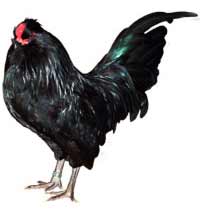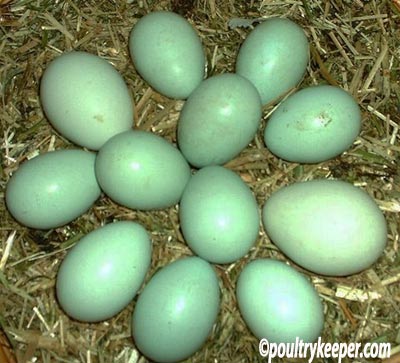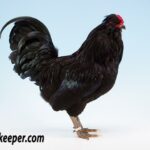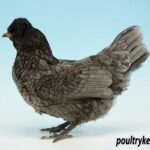
Uses: Exhibition / Eggs.
Eggs: 170-200 Green / Blue.
Origin: Chile, South America.
Weight: Cock: 2.7 – 3.2Kg Hen: 2.25 – 2.7Kg.
Bantam Cock: 740 – 850g Hen: 680 – 790g
Colours: Black, Black-Red, Blue, Blue-Red, Crele, Cuckoo, Golden Duckwing, Lavender, Pile, Silver Duckwing, Spangled, White (Standardised).
Useful to know: Called Ameraucana in America. When crossed with any other breed, the offspring will lay a green / blue egg.
Photo: Black Bantam Araucana owned by Ken Nash.
The Araucana comes from South America and are named after the Araucano tribe of Native South Americans. There are records of blue egg laying chickens in South America going back to the 1520’s. They first appeared in Europe at the World Poultry Congress in The Netherlands in 1921, exhibited by Prof. Castello who imported them around 1914.
 These were rumpless birds with pea combs and tufts of feathers growing near their ears and laid blue eggs. Rumpless birds had an advantage in the wild because predators struggled to catch them!
These were rumpless birds with pea combs and tufts of feathers growing near their ears and laid blue eggs. Rumpless birds had an advantage in the wild because predators struggled to catch them!
There has been much argument from that day to this between American and European breeders as to what Araucana chickens should look like since the original birds Prof. Castello exhibited turned out to be the result of a cross of two breeds. The mistake was corrected at the next Poultry Congress in 1924 but it was already too late, fanciers had well and truly established the Standard and had put in a lot of work to meeting this standard. Original birds had beards.
When showing Rumpless Araucanas, they are required to have beards in the U.K. In other countries, beards are also permitted, however in the U.S. they will be disqualified for having them. The original birds also had single combs which are now a disqualification at shows.
Breeding Hints
If two Araucana chickens with ear tufts are mated, only a few chicks will hatch since embryos that carry two ear tuft genes are lethal. It is best to mate a good example of a bird with ear tufts to a bird without tufts or with smaller ear tufts or just one ear tuft to get the best results. A number of embryos that have one ear tuft gene can have head deformities.
Photos
Books
The following books are available. Links take you to the Amazon or other sellers’ pages for the books.
- Popular Poultry Breeds – D. Scrivener – P.13
- Storey’s Illustrated Guide to Poultry Breeds – C. Ekarius – P. 42
- British Poultry Standards – P.40
- American Standard of Perfection (Americana) – P.198
Breed Clubs
These are the breed clubs for Araucanas:




















